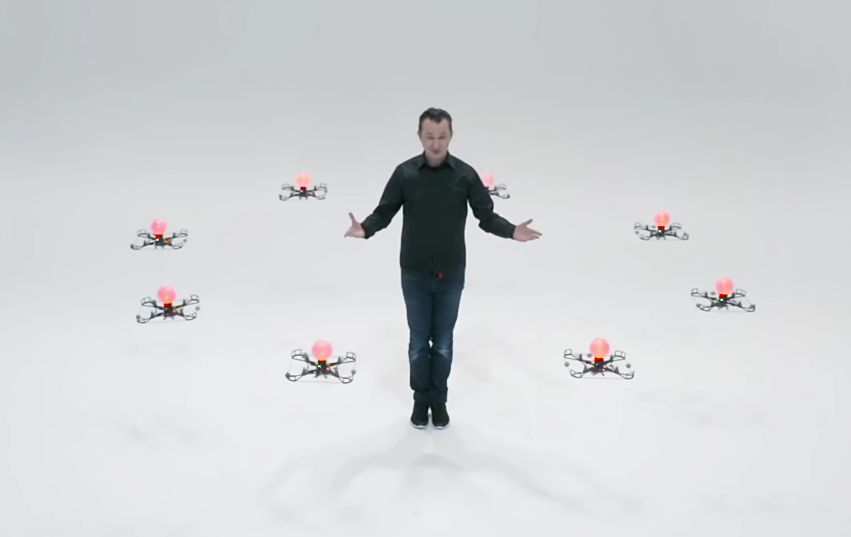
Robohub.org
The Drone Center’s Weekly Roundup: 2/15/16

Magician Marco Tempest performing with a swarm of drones. Credit: Marco Tempest/YouTube
2/1/16 – 2/7/16
At the Center for the Study of the Drone
Last week, the Pentagon released its proposed budget for Fiscal Year 2017. The budget includes nearly $4 billion for drone-related procurement, research, and construction. We have assembled a comprehensive guide to U.S. military drone spending for 2017.
News
A U.S. drone strike reportedly killed 16 members of the Islamic State in Afghanistan. The strike targeted a group of militants in the province of Achin on the Pakistan border. The targeted individuals were of Pakistani origin, according to Voice of America.
An extensive bill reauthorizing the U.S. Federal Aviation Administration has proceeded from the House Transportation and Infrastructure Committee for consideration by the House of Representatives. The proposed bill has taken on a number of new amendments relating to the use of drones, including a provision that would exempt commercial drones weighing less than 4.4 pounds from strict regulations. (Fortune)
Police in Tokyo have announced that a fleet of drones will be used to enhance security at this year’s Tokyo Marathon. The unspecified number of drones will be used to intercept rogue unmanned aircraft flying too close to the event and to collect aerial imagery. (Japan Times)
The Federal Aviation Administration has reduced the size of its no-drone zone around Washington, D.C. by half. In December, the city’s restricted airspace was expanded from a 15-mile radius around the capitol to a 30-mile radius, effectively grounding a number of model aeronautics clubs in the area. The new measure will return the zone to its original 15-mile radius size. (Washington Post)
A New Jersey man has pleaded guilty to a criminal mischief charge for shooting down a neighbor’s drone with a shotgun. Russell Percenti shot the drone out of the sky as it was hovering over his property in September 2014. (Associated Press)
Registered drones now outnumber all registered manned aircraft in the U.S., FAA Administrator Michael Huerta has announced. The FAA, which implemented a compulsory registration program for drones last fall, has recorded over 325,000 registrations. The total number of registered manned aircraft in the U.S. is roughly 320,000. (Washington Post)
Commentary, Analysis, and Art
In an in-depth essay at the New York Times Magazine, Daniel Bergner speaks with the family of Warren Weinstein, the American aid worker who was killed in a drone strike last year.
At the U.S. Naval Institute, Megan Eckstein writes that some Navy officials are pushing for the Carrier Based Aerial Refueling System drone to be deployed as soon as possible.
Meanwhile, at the Daily Beast, David Axe takes a look at what the cancellation of the UCLASS program could mean for the future of drone development.
At Lawfare, Herb Lin examines how the standing rules of engagement might be applied to drones.
At Global Guerrillas, John Robb considers how cheap, autonomous drones might transform warfare.
At The Hill, Brendan Schulman argues that a rule for micro drones in the FAA authorization bill would benefit the safe integration of drones into the national airspace.
A Canadian military report takes a look at how pirates and other maritime criminals might use new technologies like drones. (Motherboard)
At Drone Wars UK, Chris Cole considers whether the U.S. will open a drone operations center at a military base in the U.K.
At the Red Arrow Gallery in Nashville, Tennessee, Pakistani artist Mahwish Chishty and 200 local high school students collaborated on an art show about drones. (The Tennessean)
In a new video, Swiss magician Marco Tempest attempts to control a swarm of synchronized quadrotor drones. (Mashable)
Know Your Drone
U.K. technology firm Roke Manor Research is developing a cellular link system that could be mounted on high-altitude long-endurance drones to help eliminate black spots in cellular networks. (New Scientist)
Russian defense company United Instrument Manufacturing Corporation has unveiled a quadcopter mounted with an anti-tank rocket launcher. (Popular Mechanics)
Italian defense company Finmeccanica has developed a counter-drone system that uses a variety of sensors and signal jammers to track and intercept rogue drones. (Fortune)
Researchers at the University of Zurich and NCCR Robotics have developed a navigation system for drones based on deep neural networks. In testing, the system allowed a drone to autonomously navigate a trail through a dense forest. (The Verge)
Israeli defense company Elbit Systems has unveiled a new version of its Skylark tactical surveillance and reconnaissance drone. (Flightglobal)
Meanwhile, Elbit Systems has also unveiled a prototype for an unmanned frigate called Seagull, which the company has designed specifically for anti-submarine warfare operations. (Defense News)
French drone company Parrot has developed a multispectral sensor designed for crop monitoring. (Gizmag)
A team of researchers at University of California, Berkeley has created a robotic cockroach as part of a U.S. Army program to develop biologically inspired micro-unmanned systems. (Defense One)
The Defense Advanced Research Projects Agency has been flight testing highly autonomous multirotor drones at speeds of up to 45 mph in complex environments. (Washington Post)
Chinese drone maker Powervision Robot is developing a lightweight consumer drone that folds into a compact egg shape when not in use. (Gizmag)
The Netherlands Coastguard and the Royal Netherlands Air Force have conducted a series of successful flight tests of a sense-and-avoid system for large unmanned aircraft. (IHS Jane’s 360)
Drones at Work
The International Atomic Energy Association is working with Height Tech, a German drone manufacturer, to explore ways of using drones to spread thousands of sterilized mosquitoes in certain areas in an attempt to quell the Zika virus. (Bloomberg Business)
Disney has filed a patent for a system that incorporates drones into light shows. (Tech Insider)
The government of the Australian state of Victoria is looking to use drones for a variety of monitoring applications, including keeping an eye over planned forest burns. (The Herald Sun)
A drone was used to capture aerial footage of the Bab al-Salama refugee camp on the Syrian border with Turkey. (Guardian)
Archaeologists are using drones to track looting at a Bronze Age archaeological site on the Dead Sea Plain in Jordan. (Phys.org)
A Vancouver man used a drone to help him find his stolen dirt bike. (CTV News)
Industry Intel
The German navy has purchased an unmanned surface vehicle from Atlas Elektronik UK for minesweeping operations. (Press Release)
The U.S. Army awarded AAI Corp. a $19.4 million contract to modify the command and control data link on the service’s fleet of RQ-7 Shadow tactical drones. (Contract Announcement)
Helicopter transport company Bristow Group Inc. has teamed up with Sky-Futures to conduct drone inspections of offshore oil rigs. (Bloomberg Business)
Airbus has teamed up with researchers in Japan and France to develop humanoid robots. (Press Release)
For updates, news, and commentary, follow us on Twitter. The Weekly Drone Roundup is a newsletter from the Center for the Study of the Drone. It covers news, commentary, analysis and technology from the drone world. You can subscribe to the Roundup here.
tags: c-Aerial, drone news, drones, military drones




